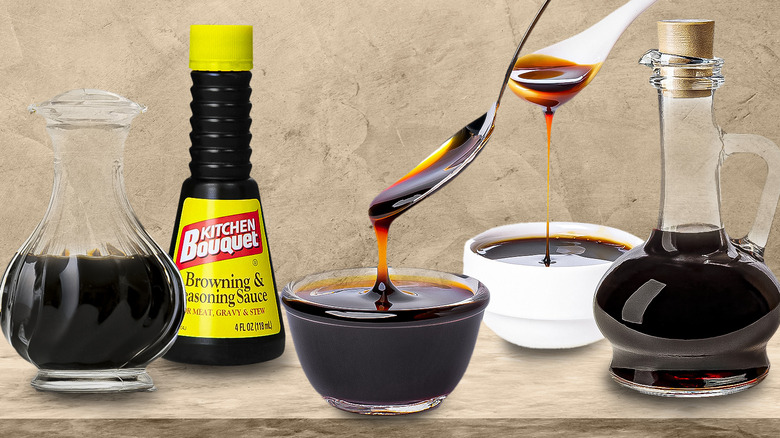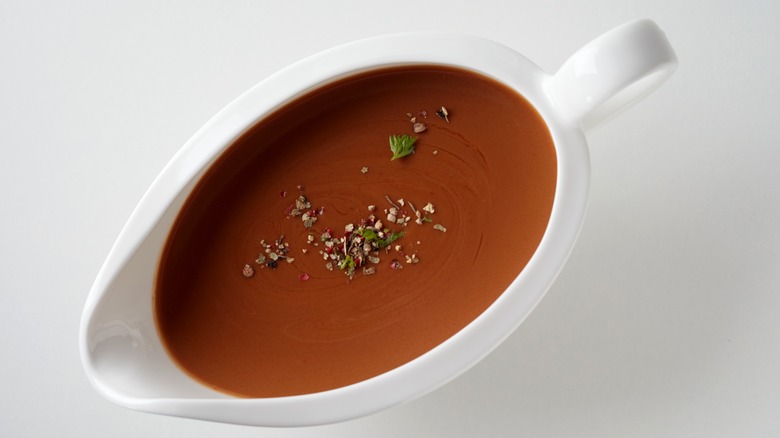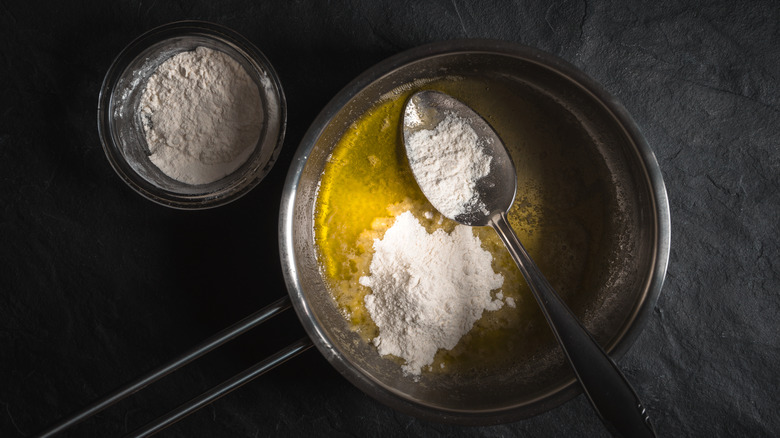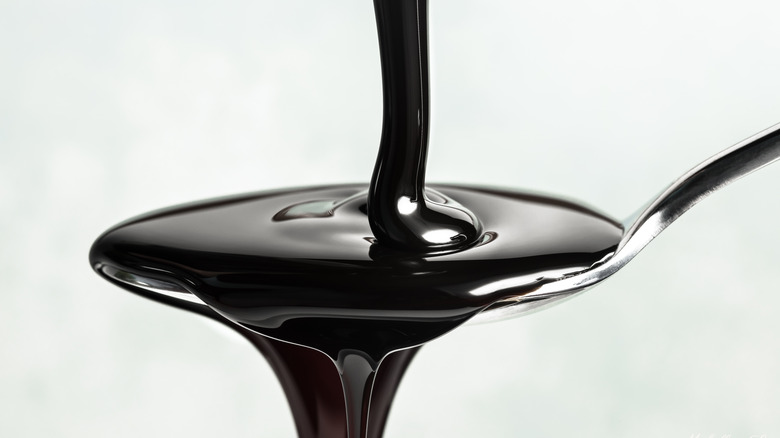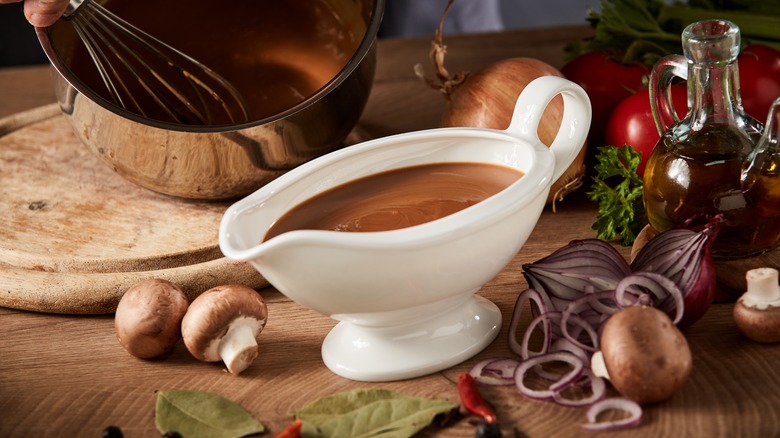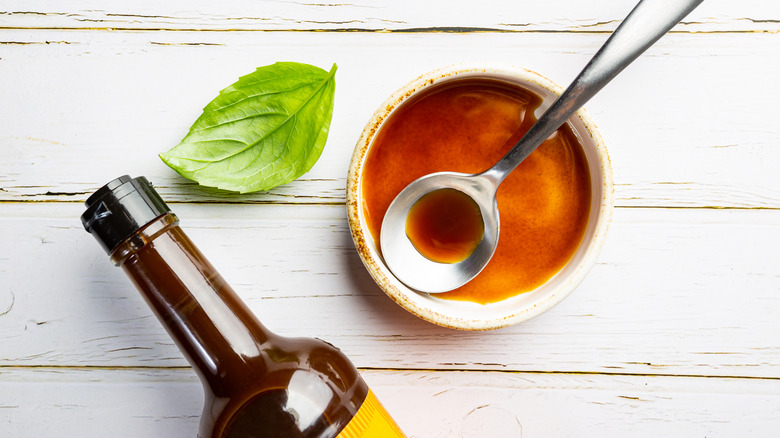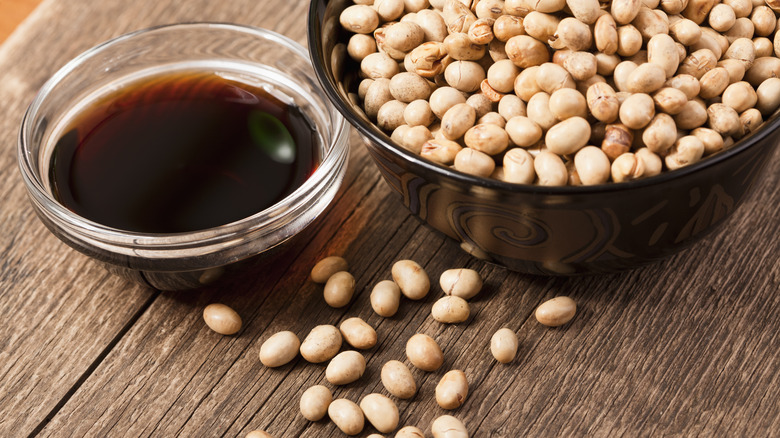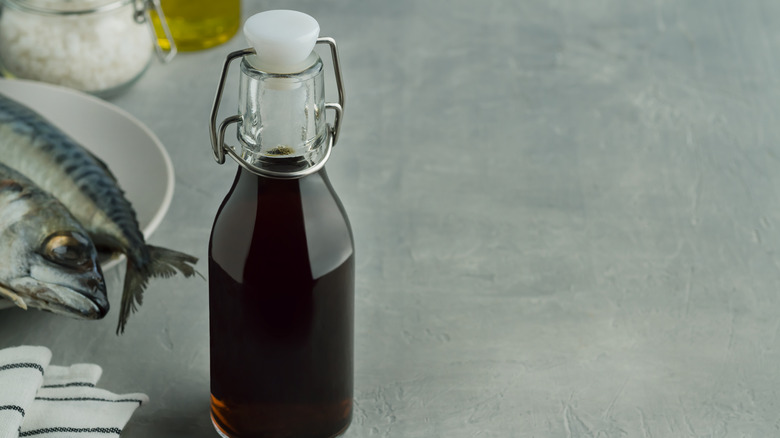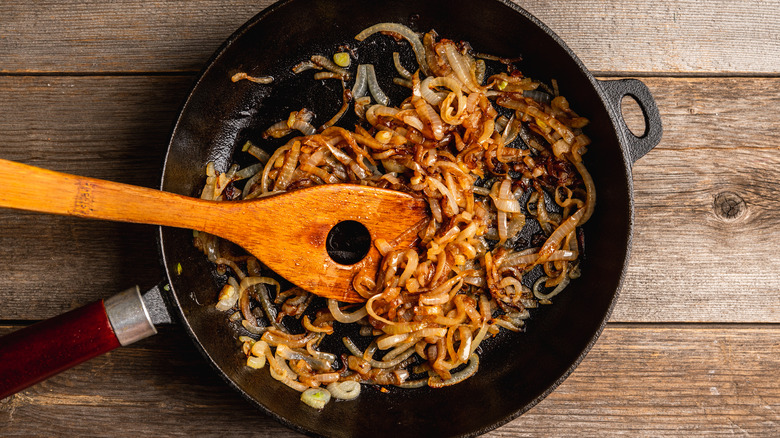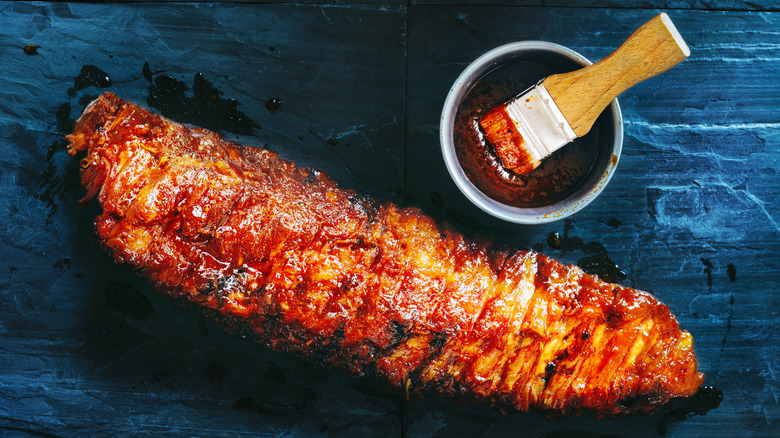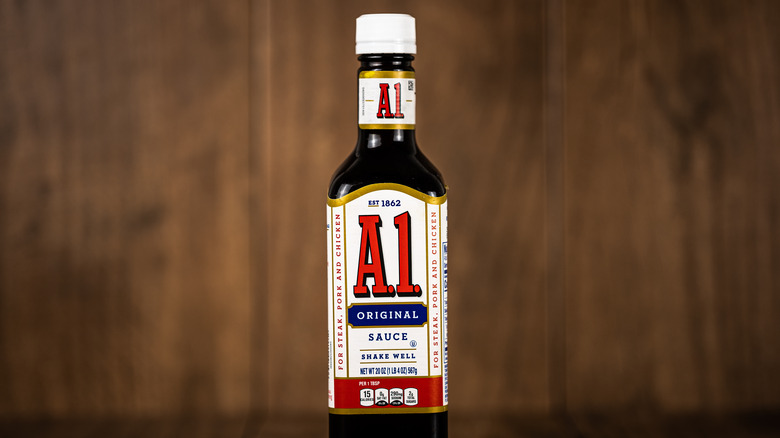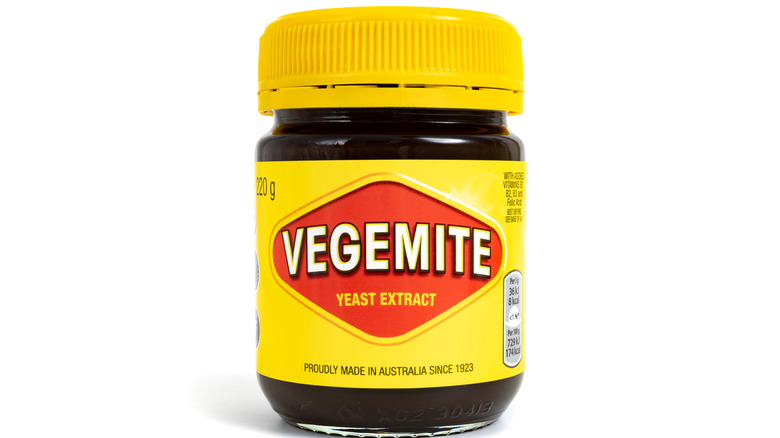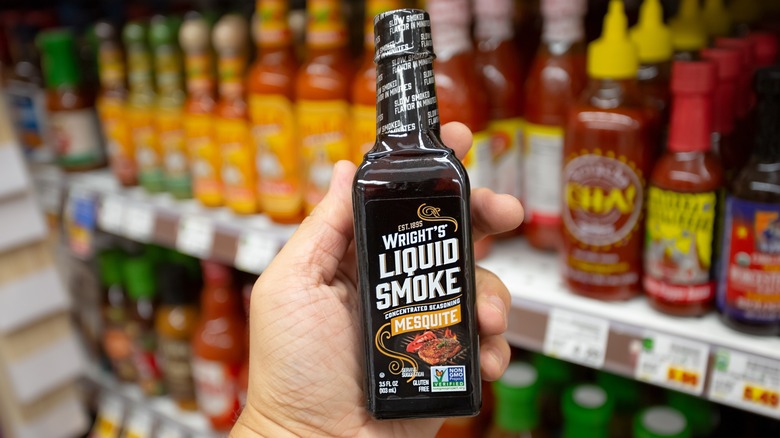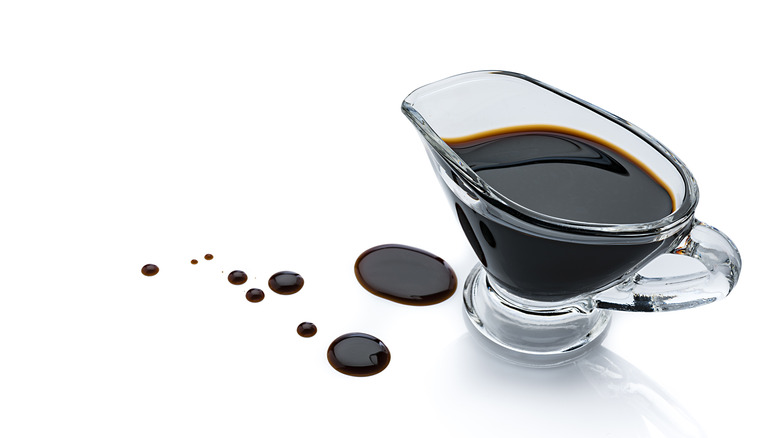14 Best Browning Sauce Substitutes To Use Instead
If you've ever made a Thanksgiving gravy that lacked color or flavor, you may have forgotten to use browning sauce. This dark, thick liquid is typically simmered in gravies, stews, and sauces or brushed onto roasts to add rich color, giving the finished dish the impression that it had slow-cooked and caramelized for hours. Two popular brands of commercially available browning sauce are Gravy Master and Kitchen Bouquet, a concentrated broth that contains vegetables and seasonings.
If you don't have a bottle on-hand, don't fret; there are plenty of ways to add dark color and savory flavors to dinner without them. Some of these browning sauce substitutes simply add color, while others add sweet notes, funky vibes, or a touch of acidic tang. Certain replacements are better for making gluten-free or plant-based meals, and others work best for simmering in sauces instead of brushing on roasting meat or vegetables, so use your best judgment when choosing the best option when preparing dinner.
1. Homemade
The easiest substitute for browning sauce is to make your own. A homemade browning sauce can be used as a substitute in recipes that call for browning sauce, although you may want to adjust the quantity according to your taste preferences. Homemade browning sauce may have a slightly different flavor profile compared to commercial brands, but it will provide a rich color and add depth of flavor to the dish.
This homemade browning sauce is sometimes called Jamaican browning sauce, as it's commonly used in Caribbean recipes. Make it by heating a cup of white sugar over medium-low heat until the sugar is melted, stirring occasionally. When the sugar turns a dark brown color, remove the pan from the heat and carefully add a tablespoon of water, stirring until the water is incorporated. Continue adding water a tablespoon at a time until you've added ½ cup in total. To deepen the flavor, you can use beef broth instead of water or add a dash of vinegar at the end. Season the browning sauce with a pinch of salt and store it in the refrigerator for up to six months.
2. Dark roux
Roux is a combination of equal parts flour and fat, and it's used as a thickening agent and flavor enhancer in sauces, soups, and gravies. There are several types of roux, and the color of your roux matters: White roux has the most thickening power and a mild flavor, while dark roux has a rich, nutty flavor. That dark roux can be used as a browning sauce substitute because it will add a similar taste and color to your recipe, enhancing the depth without adding too much thickening power.
It's important to note that roux is made with flour, so using it as a substitute means your dish will no longer be gluten-free. If this is an essential consideration for your guests, you can use a gluten-free flour blend or a gluten-free alternative such as cassava flour. Dark roux is also better used as a substitute for mixing into liquid dishes, like soups or sauces. It's too thick to work well for recipes that use browning sauce as a glaze, like brushing over a roast to give it a deeper color.
3. Molasses
Molasses is a great substitute for browning sauce because of its deep, dark color. While it doesn't have the same caramelized, umami-forward flavor as browning sauce, it does carry similar sweet undertones and a slightly bitter taste. In large quantities, molasses would bring too much sweetness to the dish, but it works exceptionally well in recipes that call for a small quantity of browning sauce.
There are three different types of molasses. Light molasses is a little too sweet to be used as a substitute here, so stick to dark molasses or blackstrap molasses. Molasses works particularly well in recipes that call for browning sauce as a flavoring and coloring agent, such as stews and gravies. It can be used as a glaze for meat dishes, although you may have to thin it out with a little water so it has a similar consistency that's easier to brush onto a roast.
4. Gravy powder
Gravy powder is a mixture of flour, seasonings, and flavorings that's designed to turn into instant gravy when combined with water. It's not an exact substitute for browning sauce, but it can be used in a pinch to add flavor to a dish. Mix a small amount of gravy powder with water and add it to your soup, stew, or gravy recipe. To boost the flavor and add a hint of color, consider mixing the gravy powder with beef broth instead of water.
While gravy powder can boost the flavor of your recipe — similar to browning sauce — it won't add much color. So, we don't recommend this substitute when the purpose of the browning sauce addition is to enrich color. Gravy powder also contains flour, so it may thicken your sauce when used in large quantities. Be sure to taste your dish and adjust the amount of liquid added based on your textural preferences.
5. Worcestershire
Worcestershire sauce may not taste exactly like the original, but it is one of the better substitutes for browning sauce. Its distinctive umami taste and deep, dark color help to add color and character to a variety of dishes. While it doesn't have the same slightly smoky flavor as browning sauce and lacks browning sauce's sweet character, Worcestershire makes up for it in savory flavor and by adding a delightful tangy taste to recipes.
When using Worcestershire sauce, keep in mind that it's more potent than browning sauce. A little goes a long way, so start by adding a small amount to the dish and adjust the quantity to taste. Worcestershire sauce is also very thin, so it may not adhere to a roast as a glaze in the same way that browning sauce can. Consider mixing it with a small amount of honey to coat the surface evenly for maximum flavor and color enhancement. It's also worth noting that most Worcestershire sauce is made with barley malt vinegar, so it's not a gluten-free ingredient. Most Worcestershire sauces are also not vegan because it contains anchovies. If these considerations are important, read the label to seek out gluten-free, vegan-friendly Worcestershire alternatives.
6. Soy sauce
Soy sauce's dark brown color makes it an excellent substitute for browning sauce when the goal is to add a caramelized hue. Adding it to soups, sauces, gravies, stir-fries, or marinades is a fantastic way to deepen the color and provide a rich visual appeal. Soy sauce will bring a distinct umami flavor — like browning sauce — but it's significantly saltier. Instead of substituting soy sauce in equal part proportions, it's best to start with small quantities and taste the dish before adding more.
Soy sauce is made from fermented soybeans but also contains wheat. For gluten-free cooking, consider exploring the difference between soy sauce and tamari. Tamari has a very similar flavor, but it's a byproduct of miso paste and typically doesn't contain wheat. Other soy sauce alternatives that can be used as a substitute for browning sauce include liquid aminos or coconut aminos for soy-free, gluten-free dishes.
7. Fish sauce
Fish sauce is exactly what it sounds like — a fish-flavored sauce that's created by fermenting fish with salt. It's bold and pungent, and it adds a lightly funky flavor and a punch of umami. There are several types of fish sauce around the world, including nuoc mam from Vietnam and nam pla from Thailand. These sauces are graded by quality, which is an important distinction when using fish sauce as a dipping sauce. As a substitution for browning sauce, however, the lower grades will work just fine. They're actually better for cooking because the sauce's protein content is less sensitive to heat.
Because fish sauce has a distinctive flavor, we recommend only using it as a substitute for browning sauce in rich soups and stews. Its unique taste would stand out in a simple sauce like gravy, which may take away from the original flavor profile. For the same reason, it's not a great stand-alone sauce for glazing meats, but it can be combined with other ingredients and added to marinades.
8. Caramelized onions
Raw onions aren't a suitable substitute for browning sauce, but this cooked version works surprisingly well. Caramelized onions are created by slow-cooking sliced onions over low heat, transforming the pungency of their raw counterparts into a delightful symphony of flavors. The onions become soft and sweet, with a savory flavor profile that lends a hint of nuttiness. They're fantastic as a topping for burgers or sandwiches, and caramelized onions will do wonders in your favorite egg dishes.
The flavor profile is a wonderful substitute for browning sauce, infusing stews and sauces with a natural sweetness and a deep, rich flavor. Of course, the onions also contain texture, so they're not great in situations that call for a smooth finish. To take advantage of the flavor without adding too much chew, try pureeing caramelized onions with water or a little broth to reduce the textural impact.
9. Barbecue sauce
Browning sauce is often used to add flavor and color to a sauce, but it's also great when brushed on meat. A little browning sauce will make a pale roast or whole chicken look like it's cooked all day long. In these instances, barbecue sauce is our go-to substitution. There are many different types of barbecue sauce, but most of them work as a swap because they contain sugar. That sugar browns as it's exposed to heat, giving the meat an ideal finishing color.
You'll want to choose your barbecue sauce wisely here, as some barbecue sauces pair better with certain meats. Look to Memphis-style barbecue sauce when you want to feature sweet and spicy flavors or Kansas City-style barbecue sauce to balance the sweetness with a hint of tang. Carolina-style barbecue is highly acidic thanks to the addition of vinegar, so it will be sharper and more sour than other sauces. Avoid Alabama or white barbecue sauce here, as this mayonnaise-based sauce will not glaze the same as tomato-based barbecue sauces.
10. A1 Original Steak Sauce
If there's a sauce that's synonymous with enhancing the flavor of cooked meats, it's probably A1 Original Steak Sauce. The history behind steak sauce's association with meat started with an all-purpose sauce geared toward all kinds of dishes, from meat to seafood, stews, and cheese on toast. In the 1960s, Kraft Heinz Company branded the sauce as "steak sauce," forever solidifying its connection with beef.
That said, A1 has the right character to enhance a number of different dishes, making it an ideal browning sauce substitute. It contains flavors of tomato, vinegar, and oranges blended with garlic and onion, spices, and a hint of sweetness from raisin paste, resulting in a tangy, sweet, and savory concoction. A small dash is enough to will take a regular gravy to the next level, and its deep brown color will add depth to finished dishes. That color also makes it equally ideal for glazing meats as they cook.
11. Marmite or Vegemite
These two brands of yeast extract spreads are often referred to interchangeably. However, when you dig a little deeper, there is a real difference between Marmite and Vegemite. Both are made from concentrated brewer's yeast extract combined with various spices and vegetable extracts, but Marmite originated in the United Kingdom. It's savory and salty with a hint of sweetness, and it's dark brown in color with the consistency of molasses. Vegemite, on the other hand, comes from Australia. The flavor is more intense and more bitter, and the thick paste is so dark it's almost black.
Instead of using them in their traditional use — scraped onto toast — try using these yeast extracts as a substitute for browning sauce. Marmite's thin consistency would be better suited for glazing meats, while Vegemite's dark color makes it ideal for adding color to gravies. Because both products are intense and salty, start small. You can always add more, but it's impossible to add less once it's in the pot!
12. Instant coffee or espresso
While most people prefer the flavor of brewed coffee to the instant variety, we recommend keeping a jar of instant coffee or espresso powder in the pantry anyway. These products add a subtle coffee flavor to desserts and baked goods, give syrups a bold-flavored finish, and can be mixed with herbs and spices for dry rubs and marinades. We also love instant coffee as a substitute for browning sauce to add a rich, dark color and a hint of bitterness to your recipes.
Instead of incorporating instant coffee as a glaze while the meat is cooking, try massaging the powder onto raw meats and letting it marinate before cooking. The coffee will turn into a glaze as it combines with the juices as the meat cooks. For sauces and gravies, dissolve instant coffee or espresso powder in a small amount of hot water to create a concentrated solution that can be whisked into finished dishes.
13. Liquid smoke
Browning sauce has a slightly smoky flavor that is hard to replicate with other browning sauce substitutes. That makes liquid smoke a good solution if you don't have browning sauce on hand. Liquid smoke is made by burning hardwood chips or sawdust at high temperatures and collecting the smoke in condensers. The concentrated liquid contains a strong essence of smoke, and its usually available in several flavors, including hickory, mesquite, and applewood.
Liquid smoke is highly potent and incredibly intense, so we generally recommend combining this liquid with another browning sauce substitute. Try adding a few drops to soy sauce or molasses to amp up the smoky vibes without creating an overpowering flavor. Liquid smoke can also be diluted into broth, water, or a neutral oil like canola oil. If you do happen to go overboard with the liquid smoke, try balancing the flavors by adding a little honey or citrus juice to your dish.
14. Balsamic vinegar or balsamic glaze
Most vinegar is too acidic to use as a browning sauce substitute. Balsamic vinegar is in a league of its own, though, with its dark color, rich flavor, and almost syrupy consistency. It has a sweeter character than most vinegar, especially balsamic vinegar which has been aged in oak barrels for many years.
Swirling a little balsamic vinegar into soups or sauces will deepen the color and bring out rich, flavorful elements. Vinegar can curdle milk, so we don't recommend using this substitution when making dairy-based sauces like gravy or bechamel sauce. The vinegar can be too thin to be used as a glaze, but you can purchase balsamic glaze to use to brush on meats as they finish. Making balsamic glaze is easier than you might think, too. Simply reduce balsamic vinegar in a saucepan, simmering it for about 15 minutes until it's thick enough to coat the back of a spoon.
